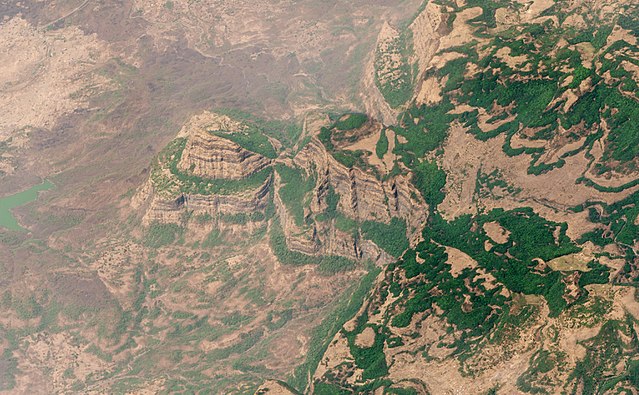The Deccan Traps is a large igneous province of west-central India. It is one of the largest volcanic features on Earth, taking the form of a large shield volcano. It consists of numerous layers of solidified flood basalt that together are more than about 2,000 metres (6,600 ft) thick, cover an area of about 500,000 square kilometres (200,000 sq mi), and have a volume of about 1,000,000 cubic kilometres (200,000 cu mi). Originally, the Deccan Traps may have covered about 1,500,000 square kilometres (600,000 sq mi), with a correspondingly larger original volume. This volume overlies the Archean age Indian Shield, which is likely the lithology the province passed through during eruption. The province is commonly divided into four subprovinces: the main Deccan, the Malwa Plateau, the Mandla Lobe, and the Saurashtran Plateau.
The Western Ghats at Matheran in Maharashtra
Oblique satellite view of the Deccan Traps
Deccan Traps at Ajanta Caves
Crystals of epistilbite and calcite in a vug in Deccan Traps basalt lava from Jalgaon District, Maharashtra
A large igneous province (LIP) is an extremely large accumulation of igneous rocks, including intrusive and extrusive, arising when magma travels through the crust towards the surface. The formation of LIPs is variously attributed to mantle plumes or to processes associated with divergent plate tectonics. The formation of some of the LIPs in the past 500 million years coincide in time with mass extinctions and rapid climatic changes, which has led to numerous hypotheses about causal relationships. LIPs are fundamentally different from any other currently active volcanoes or volcanic systems.
Three Devils Grade in Moses Coulee, Washington is part of the Columbia River Basalt Group LIP.
Illustration showing a vertical dike and a horizontal sill.






